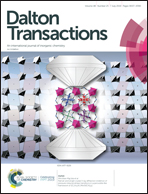The catalytic activities and magnetic behaviours of rare μ3-chlorido and μ1,1,1-azido bridged defective dicubane tetranuclear Mn(ii) complexes†
Abstract
Reaction of Mn(II) salts with a flexidentate Mannich base ligand, N,N′-dimethyl-N,N′-bis(2-hydroxy-3-methoxy-5-methylbenzyl)ethylenediamine (H2L) in the presence of chloride or azide ions yielded two new tetranuclear complexes, [Mn4L2(μ3-Cl)2Cl2] (1) and [Mn4L2(μ1,1,1-N3)2(N3)2] (2). Single crystal X-ray structural analyses reveal that these two discrete tetranuclear Mn(II) complexes possess defective dicubane cores with two μ3-Cl (for 1) or two μ1,1,1-N3 bridges (for 2). One of the triply bridging groups is situated above and the other one below the plane of the four Mn(II) ions. In both complexes, all Mn(II) ions are in a hexa-coordinated distorted octahedral environment. Both complexes 1 and 2 exhibit catecholase like activity and phenoxazinone synthase-like activity under ambient conditions. The turnover numbers (kcat) for the aerobic oxidation of 3,5-di-tert-butylcatechol are 1492.4 and 1431.2 h−1 and those of o-aminophenol are 2265.5 and 2132.2 h−1 for complexes 1 and 2, respectively. Mass spectral analyses were performed to get an idea about the probable mechanistic pathway for these catalytic reactions. Variable temperature magnetic susceptibility measurements of a solid sample reveal that both the complexes are antiferromagnetically coupled. The coupling constants are calculated to be J1 = −0.19 cm−1, J2 = −6.87 cm−1 and J3 = −0.70 cm−1 for 1 and J1 = 0.11 cm−1, J2 = −0.64 cm−1 and J3 = 0.11 cm−1 for 2 and these values are rationalized by DFT calculations.



 Please wait while we load your content...
Please wait while we load your content...